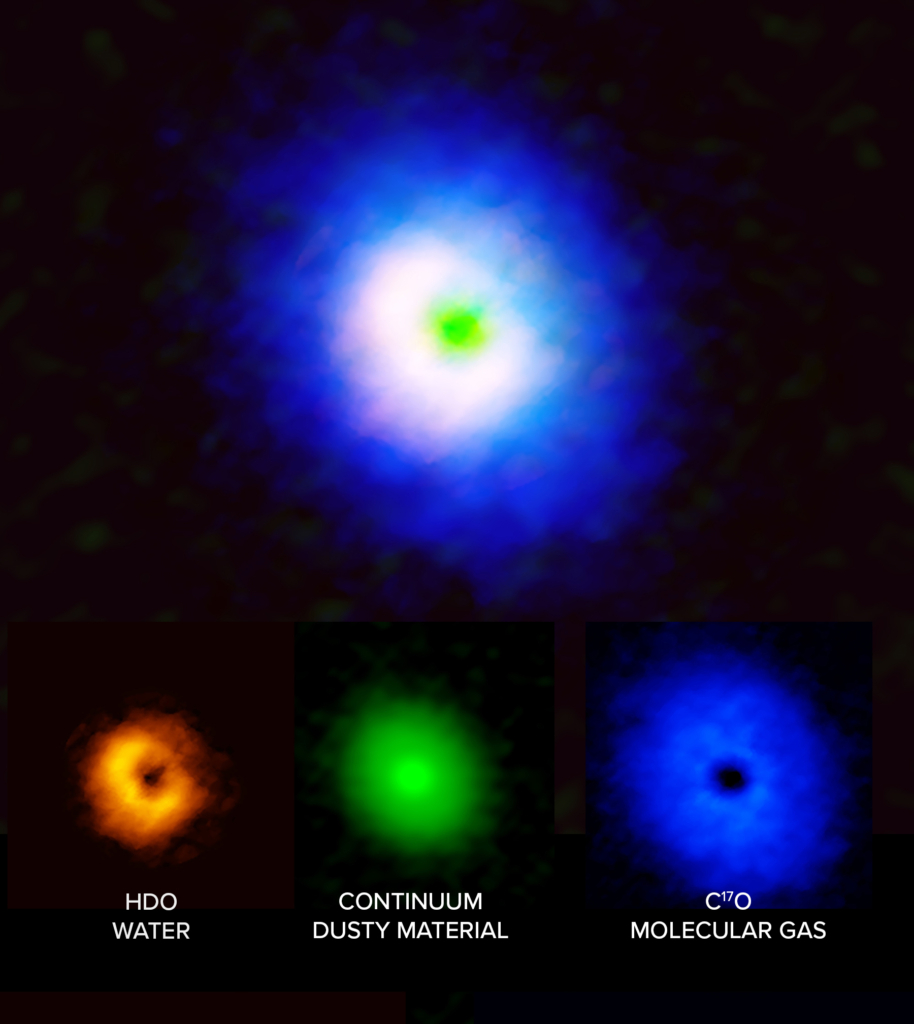Formation Back to the Interstellar Medium
ALMA | NRAO | NAOJ | ESO | 2023 Mar 08
Observations of water in the disk forming around protostar V883 Ori has unlocked clues about the formation of comets and planetesimals in our own Solar System
Scientists studying a nearby protostar have detected the presence of water in its circumstellar disk. The new observations made with the Atacama Large Millimeter/submillimeter Array (ALMA) mark the first detection of water being inherited into a protoplanetary disk without significant changes to its composition. These results further suggest that the water in our Solar System formed billions of years before the Sun. ...Credit: ALMA (ESO/NAOJ/NRAO), J. Tobin, B. Saxton (NRAO/AUI/NSF)
- While searching for the origins of water in our Solar System, scientists homed in on V883 Orionis, a unique protostar located 1,305 light-years away from Earth. Unlike with other protostars, the circumstellar disk surrounding V883 Ori is just hot enough that the water in it has transformed from ice into gas, making it possible for scientists to study its composition.
V883 Orionis is a protostar located roughly 1,305 light-years from Earth in the constellation Orion. The new observations of this protostar have helped scientists to find a probable link between the water in the interstellar medium and the water in our Solar System by confirming they have similar composition.
“We can think of the path of water through the Universe as a trail. We know what the endpoints look like, which are water on planets and in comets, but we wanted to trace that trail back to the origins of water,” said John Tobin ... “Before now, we could link the Earth to comets, and protostars to the interstellar medium, but we couldn’t link protostars to comets. V883 Ori has changed that, and proven the water molecules in that system and in our Solar System have a similar ratio of deuterium and hydrogen.”
Observing water in the circumstellar disks around protostars is difficult because in most systems water is present in the form of ice. When scientists observe protostars they’re looking for the water snow line or ice line, which is the place where water transitions from predominantly ice to gas, which radio astronomy can observe in detail. “If the snow line is located too close to the star, there isn’t enough gaseous water to be easily detectable and the dusty disk may block out a lot of the water emission. But if the snow line is located further from the star, there is sufficient gaseous water to be detectable, and that’s the case with V883 Ori,” said Tobin, who added that the unique state of the protostar is what made this project possible.
V883 Ori’s disk is quite massive and is just hot enough that the water in it has turned from ice to gas. That makes this protostar an ideal target for studying the growth and evolution of solar systems at radio wavelengths. ...
Astronomers Find Missing Link for Water in the Solar System
ESO Science Release | ALMA | 2023 Mar 08
Deuterium-Enriched Water Ties Planet-Forming Disks to Comets and Protostars ~ John J. Tobin et al
- Nature 615(7951):227 (09 Mar 2023) DOI: 10.1038/s41586-022-05676-z
